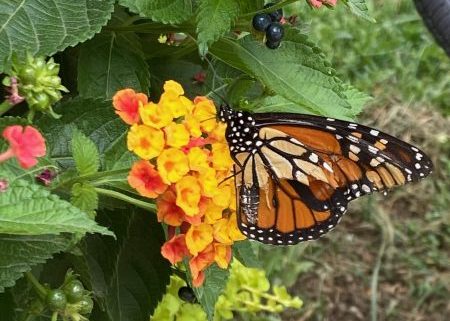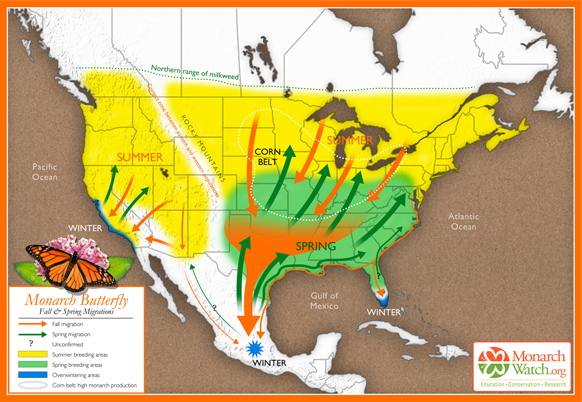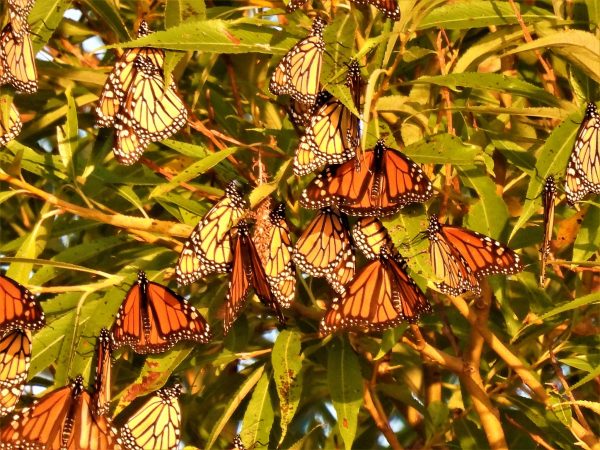As San Antonio and the Texas Hill Country approach peak monarch butterfly migration season October 10 – 22, the forecast for this year’s crop of iconic orange-and-black insects does not look great.
A hard freeze in Texas this spring followed by months of drought and record 100-degree days has set the stage for a challenging year.
“Not a great year for pollinators in general, I’d say,” said Molly Keck, entomologist for the Texas Agrilife Extension Service in Bexar County.
The freeze hit Texas in March, stopping many of the milkweeds that typically sprout in spring in their tracks. Milkweed is the only plant on which monarchs lay their eggs. As a result, the monarchs returning from Mexico this spring found no host plant on which to lay the eggs of 2022’s first generation of monarchs and continued flying. Many perished along the way.

This tattered monarch on lantana was spotted in Lawrence, Kansas, this week. Photo by Monika Maeckle
Then came the drought.
Keck said the lack of rain has resulted in little nectar availability in many parts of Texas.
While laying eggs on milkweed and reproducing is their priority in the spring and summer, in the fall, monarchs’ agenda is to load up on nectar. Autumn is when they migrate back through what’s known as the “Texas Funnel” en route to their roosting sites in Mexico. The insects are programmed to build up their fat stores, which allows them to make it through the winter.
“Some people’s gardens are finally blooming if they planted the right things,” said Keck, referring to the welcome rains central Texas experienced several weeks ago. The downpour in August was the first significant rain in the area since last September. “It’s been a brown and not very green this year,” she said.
While Texas is just approaching peak monarch migration, the season is winding down up north.
Don Davis of Toronto, an avid monarch butterfly follower who has been tracking and tagging monarchs for decades, said via email that the butterflies were uncommon in his area until about mid August, when the migration became more noticeable.
“We were plagued by hot dry weather, and the lack of rain hindered monarch reproduction. Some rains arrived about mid August, but we still need more,” he said.

Monarch butterflies start their mulit-generation migration in Mexico in the spring, move north over the summer, and return south in the fall. –Map via Monarch Watch
Davis said a cold front pushed monarchs south last week and he and others reported significant roosts in Southern Ontario. Ultimately though, he anticipates a smaller population this year.
“I suspect that monarch numbers will be lower in Mexico,” he said. “I am concerned by the very hot and dry conditions the monarchs will migrate through in the southern U.S.A., and Texas in particular.”
Dry conditions take a huge toll on the migrating creatures. Cooler weather allows them to burn fewer calories and maintain their lipids–the fats they use to get through the winter. Hot weather does the opposite, forcing energy use.
Cathy Downs, a conservation specialist for Monarch Watch, the University of Kansas monarch butterfly citizen science tagging and conservation program, is more optimistic. Based outside San Antonio in Comfort, Texas, Downs said she’s seen about a dozen monarchs and heard reports of more in the Texas Hill Country.
Downs credited 4 1/2 “ of recent rains for rejuvenating some of the native flowering plants in her area.
“Let’s hope we have a little more rain to sustain favorable conditions until they begin migrating in earnest,” she said.
Monarch Watch founder, Chip Taylor, was less hopeful.”This is going to be a low migration, that’s all we know,” he said. “By a significant amount.”
TOP PHOTO: Monarch butterflies cluster in Canada earlier this month. –Photo by Don Davis
Related Articles:
- On the Llano River in the Texas Hill Country, recent rains bode well for monarch butterfly migration
- Dejavu: is 2022’s dry spell setting the stage for another Texas drought like 2011?
- Forever Journey: honor someone who died by tagging a monarch butterfly in their name
- Caterpillar condos tap monarch butterfly migration for hands-on nature lessons
- Three monarch butterflies tagged in honor of those who died recovered in Mexico
- Two monarchs tagged on the Llano River in honor of lost loved ones recovered in Mexico
- They’re here! Drought conditions greet monarch butterflies as they arrive in Texas
- Massive arrivals of monarch butterflies in the Texas Hill Country signal 2021 migration is on
Like what you’re reading? Don’t miss a single post from the Texas Butterfly Ranch. Sign up for email delivery, like us on Facebook, or follow us on Twitter, @monikam or Instagram.



Monarch reproductive success in the lower Midwest must have been good last Spring because Dr. Chip Taylor made the following comments about monarch abundance as of May 23, 2022:
“These are the first sightings recorded by Journey North through May 23 this year. As you can see there are a tremendous number of first sightings. This is unusual. This is pretty unique to see this many red dots in the upper Midwest north of 40 degrees latitude north. Whenever we see something like that it signals that this population is going to grow really well this year.” Source: the 48.37 – 49.47 minute marks in this video: https://youtu.be/g4H4tGwo0gI
I live in Ohio and our monarchs are very low this year. I think I’ve only seen about a dozen. Last year we hatched about 40 one day and 60 the next. I didn’t get any this year.
I live in the San Francisco Bay area of Northern California and I frequently see Monarchs .
I live in Orange County So. Cal. we had our best year, we released approx. 80/90 Monarchs. And our neighbor had about the same. Not as many Gulf Fritillary butterflies, but a great amount of Sulfer butterflies that produced many cats. We released our last monarch at the end of August and although we have had a constant number of monarchs in our yard, both front and back they haven’t produced any more cats that i have seen. We have four different types of native milkweed in our yard, but the clear favorite is the Tropical hands down for nectar and egg laying. We still have plenty of Gulf and Sulfers but the Monarchs are few and far between.
I also live in OC, So Cal and we released about 100 Monarchs. We have a hard time though with the native Narrowleaf milkweed. Any hint or information on how to successfully grow the Narrowleaf? What other native milkweeds do we have? I didn’t know about Gulf and Sulfers Monarchs. Thanks!
We are in the hill country in Boerne TX, the last four days we’ve seen hundreds flying east. They look very healthy and are very determined little guys.
Very dry here but the temps are finally coming down.
Today is the first time I noticed a clear increase in Monarchs in Wichita Falls
They are all here in southeast Alabama. I have never seen so many here.
I live in northern Indiana and I saw 5 monarchs on October 10 that was the last day they were heading south- our weather turned and snowing this week hopefully they were able to fly south enough. I also found 2cats and fed them milk weed , now I have 2 chrysalis and I winter in Florida hopefully I can release them there.
I live in San Antonio, TX and brought some tropical Milkweed plants into my greenhouse. I noticed some Monarch
caterpillars on them. They now have turned into chrysalises. What do I do now???
Let them do their thing.